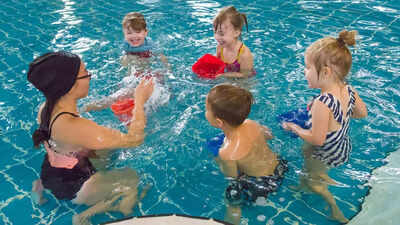10 Great Reasons for Kids to Take Swimming Lessons

Drowning is a major cause of accidental death among young children. While swimming lessons can’t eliminate the risk entirely, they can greatly reduce it. Kids learn important survival skills like floating, treading water, and swimming to safety.
A Harvard Health article highlights that early swim lessons can be a powerful tool in protecting children around water.
Why Age 4 is Ideal for Starting Swimming Lessons
By age 4, most kids have developed the skills needed for structured learning. They can listen, follow instructions, and remember what they’ve learned. Some children may be ready a bit earlier, but age 4 is generally when they can start to understand swimming techniques and safety concepts.
Early Swim Lessons Have Value
Even though kids under 4 may not be ready for formal swim strokes, early swim lessons can still be helpful. Toddlers can learn basic water safety skills like floating, turning around in the water, or reaching the pool’s edge. These skills can make a big difference in an accidental water situation. Early exposure also helps kids feel comfortable in the water, reducing fear later on.
The Learning Environment Must Be Safe
Safety should always be a priority. The pool or beach area should be clean, well-maintained, and have clear boundaries between shallow and deep water. Lifeguards should be on duty, focused solely on safety. There should also be protective barriers, visible safety rules, first-aid kits, and lifesaving equipment nearby.
Instructors Should Be Trained and Certified
Not all swim teachers are qualified, so parents should ask about instructor training. Ideally, teachers should be certified by recognized organizations like the Red Cross or YMCA. These organizations follow strict guidelines for water safety and child instruction. Trained instructors can teach effectively and respond to emergencies.
Class Sizes Should Be Small
The number of children per instructor should be low, especially for young learners. A good rule is that the instructor should be able to keep every child within arm’s reach. As children become more confident, class sizes can increase slightly, but safety and individual attention must always come first.
A Structured Curriculum is Essential
A good swim program follows a clear curriculum. This helps children advance step-by-step, from basic water comfort to strokes like freestyle. Children should be assessed based on their ability and placed in the appropriate level. Progression should be measurable, with set goals showing how children are improving.
Parents Should Observe Lessons
Parents should be able to see what their child is learning. Many facilities allow parents to watch parts of the session from a designated area. This helps parents stay informed about their child’s progress and reinforces trust in the teaching process.
Flotation Devices Can Be Useful
Flotation aids can offer valuable support for beginners. They keep children safe while they learn proper body positioning and stroke movements. However, overdependence on these aids can slow down skill development.
Fear of Water is Common and Can Be Managed
Many children feel scared when they first enter a pool. This fear is natural. Instructors should be patient, encouraging, and experienced in working with nervous children. They should use games, reassurance, and praise to build trust and comfort over time.
Swimming Lessons Don’t Eliminate Drowning Risks
Even good swimmers are not immune to danger in or around water. Accidents can happen if a child becomes tired, disoriented, or injured. Adult supervision is always necessary, regardless of swimming ability. Life jackets are essential for activities like boating or playing in open water. Swimming lessons are important, but they are not a substitute for vigilance and proper equipment.



